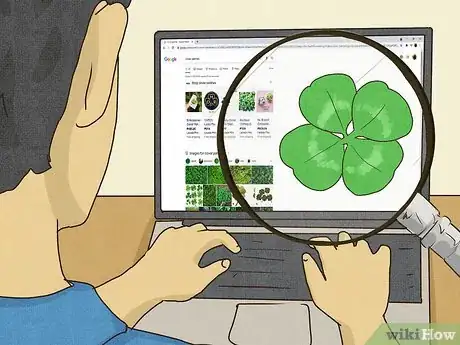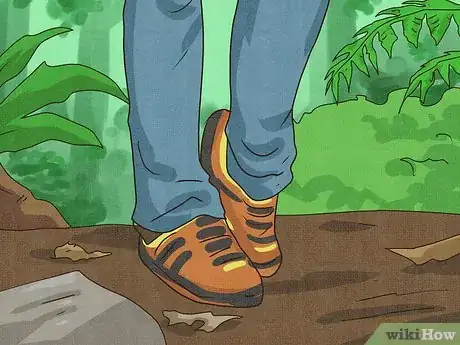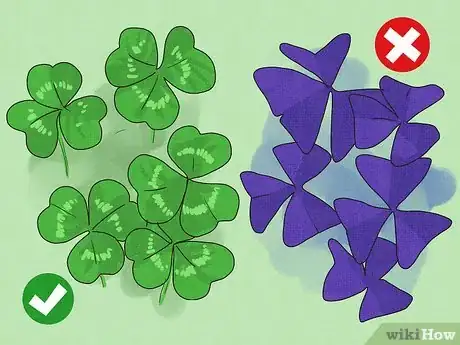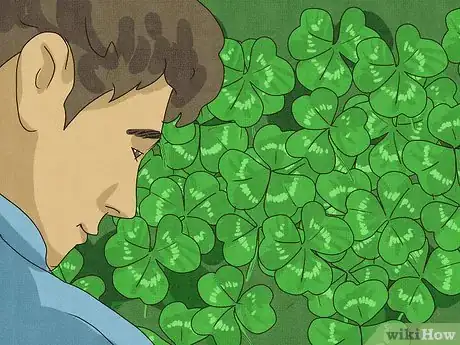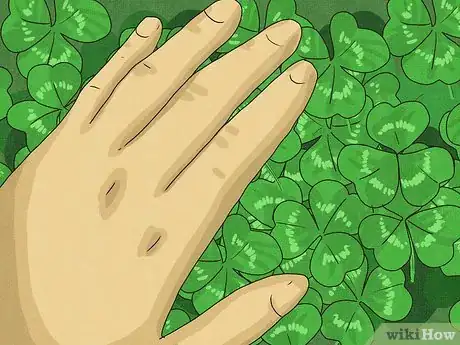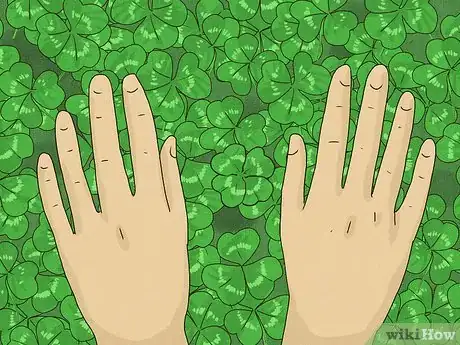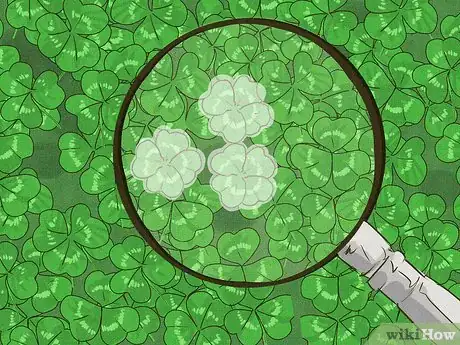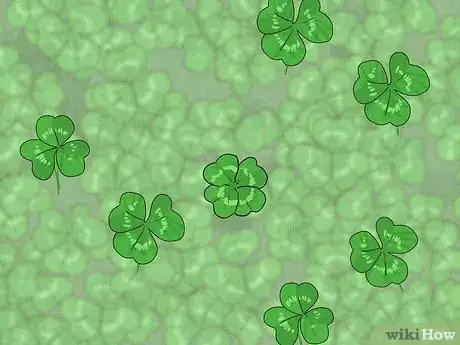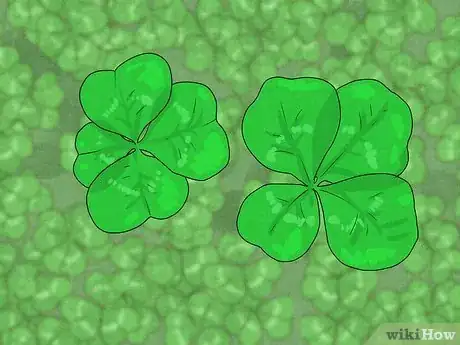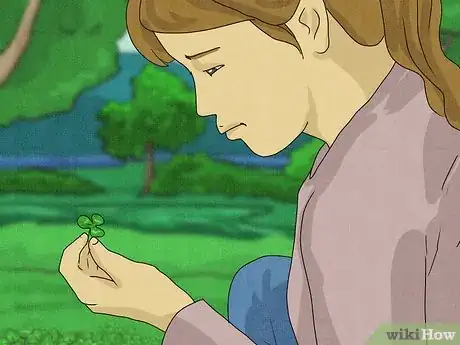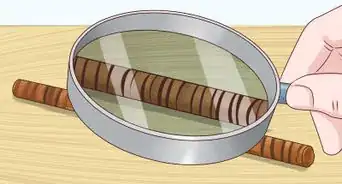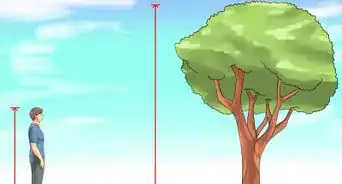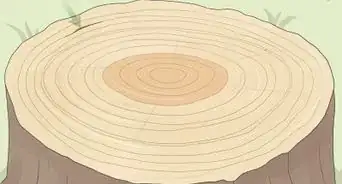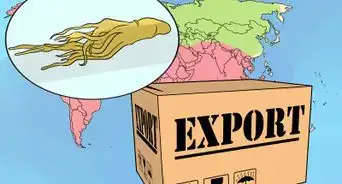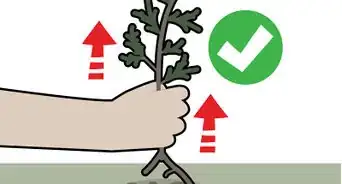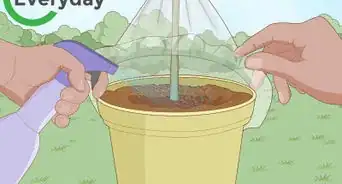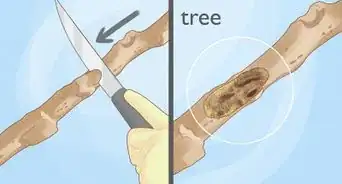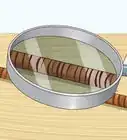This article was co-authored by wikiHow Staff. Our trained team of editors and researchers validate articles for accuracy and comprehensiveness. wikiHow's Content Management Team carefully monitors the work from our editorial staff to ensure that each article is backed by trusted research and meets our high quality standards.
There are 7 references cited in this article, which can be found at the bottom of the page.
wikiHow marks an article as reader-approved once it receives enough positive feedback. In this case, 88% of readers who voted found the article helpful, earning it our reader-approved status.
This article has been viewed 613,486 times.
Learn more...
Four-leaf clovers are believed to give the finder good luck and fortune. Due to their rarity, they can also be a fun souvenir to have. To find a four-leaf clover, find some clover patches in your area and scan them for a four-leaf clover. Be patient and keep looking, as four-leaf clovers are rare. If you don't find one the first time you go out hunting, keep your eyes peeled in the future. With some dedication, you should eventually find a four-leaf clover of your own.
Steps
Locating Clover Patches
-
1Do an online search for clovers in your area. If you're not sure where to find clovers in your area, do an online search for "clover patches" followed by the name of your town. You may find sites with an overview of the types of foliage in the different areas of your town. Users may also leave comments about local parks or trials on sites like Yelp, letting other people know the kinds of plants they found there.
-
2Walk around local areas with a lot of foliage. If you can't find clovers online, do your own search. Walk around areas with a lot of leaves and trees, like parks and trials, to seek out clover patches.[1]
- If you have a backyard, look there as well. Clovers often grow in lawns.
Advertisement -
3Check shady, dry areas. Clovers tend to thrive in soil that does not drain well. They also frequently grow in the shade. When out looking for clovers, check shady and dry areas for a clover patch.[2]
-
4Identify a clover patch. Clover patches are comprised of plants with small green flowers circling a center point. Watch out for plants that look similar to clovers. Plants with purple circles at the center are not clovers. Also, if you see a whole patch of what look like four-leaf clovers, these are not clovers.[3] Remember, four-leaf clovers are rare. There is one four-leaf clover for every 10,000 three-leaf clover in a patch.[4]
Searching for a Four-Leaf Clover
-
1Scan the patch carefully. Do not try to look at every clover individually, as this will take far too long. Instead, stand above the patch and scan it closely. Pause if a clover jumps out at you and check to see if it has four leaves.[5]
-
2Skim the surface with your hands. If scanning from a distance isn't working, crouch near the clover patch. Run your hands over the clover patch slowly. Focus in on the clovers as they pass through your fingers, checking for clovers with extra leaves.[6]
-
3Push the leaves apart if you think you see a four-leaf clover. If you see what appears to be a four-leaf clover, push away the clovers surrounding it. See if it actually has four leaves. Clovers sometimes look like they have four leaves, but you're really seeing leaves from another clover clustering near it.[7]
-
4Look in the same area if you find a four leaf clover. If you happen to find a four-leaf clover, keep looking in that area. Four-leaf clovers are caused by a genetic mutation. Therefore, they tend to be found close together as the seeds will spread around the same area. You may be lucky enough to find a second four-leaf clover.[8]
Avoiding Common Mistakes
-
1Don't try to look at every individual clover. Scanning the leaves works better than examining every leaf. As there are hundreds of clovers in a single patch, you won't have time to look at them all. If you scan the leaves instead, a difference in the general pattern may jump out at you.[9]
-
2Look for smaller leaves on four-leaf clovers. Don't expect a four-leaf clover to have completely even leaves. Keep in mind, when scanning for a four-leaf clover, the clover's fourth leaf may be significantly smaller than the others.[10]
-
3Don't get discouraged. Four-leaf clovers are incredibly rare. The more often you search, the more likely you are to find one. If you don't find a four-leaf clover on your first search, keep an eye out each time you pass a clover patch. The more often you look, the more likely you are to eventually find a four-leaf clover.[11]
Community Q&A
-
QuestionWhat makes four leaf clovers so rare?
 Community AnswerResearchers at the University of Georgia have found a rare recessive gene that causes clovers to have three leaves more often than they have four leaves.
Community AnswerResearchers at the University of Georgia have found a rare recessive gene that causes clovers to have three leaves more often than they have four leaves. -
QuestionI think that the best time to find a four leaf clover is when it is raining or soggy outside and it is really cool.
 Community AnswerYou might be right, for that might be your lucky time. Perhaps you have a reason you might share with us as to why this time works best for you - maybe the extra leaf causes the plant to show itself differently in the rain, perhaps it sags more?
Community AnswerYou might be right, for that might be your lucky time. Perhaps you have a reason you might share with us as to why this time works best for you - maybe the extra leaf causes the plant to show itself differently in the rain, perhaps it sags more? -
QuestionWhy don't they grow well in flowerbeds?
 Community AnswerWhen another plant is already taking up the soil nutrients, space and light, other plants find it hard to compete. If the flowerbed is well tended, all weed plants (including clover) will also be frequently removed. However, a flowerbed that is sparse and poorly cared for might allow clover to grow.
Community AnswerWhen another plant is already taking up the soil nutrients, space and light, other plants find it hard to compete. If the flowerbed is well tended, all weed plants (including clover) will also be frequently removed. However, a flowerbed that is sparse and poorly cared for might allow clover to grow.
References
- ↑ https://www.homestratosphere.com/what-is-a-clover-plant/
- ↑ https://www.almanac.com/content/clover-comeback
- ↑ https://realfarmacy.com/four-leaf-clovers-how-to-find-and-plant-them/
- ↑ https://www.sciencefocus.com/nature/why-are-four-leaf-clovers-so-rare/
- ↑ http://www.smithsonianmag.com/smart-news/how-find-four-leaf-clover-180950114/
- ↑ https://thewalrus.ca/how-to-find-a-four-leaf-clover/
- ↑ https://www.science101.com/how-to-find-a-real-four-leaf-clover/
- ↑ https://realfarmacy.com/four-leaf-clovers-how-to-find-and-plant-them/
- ↑ http://www.smithsonianmag.com/smart-news/how-find-four-leaf-clover-180950114/
About This Article
To find a four-leaf clover, stand over the clover patch and scan for any clovers that catch your eye or look different. Avoid inspecting every single clover in the patch, though, since this can be time-consuming! You can also run your hands over the clover patch slowly and feel for clovers that have extra leaves. If you happen to find a four-leaf clover, keep looking in that area, since they tend to grow close together! For tips on locating clover patches, read on!
